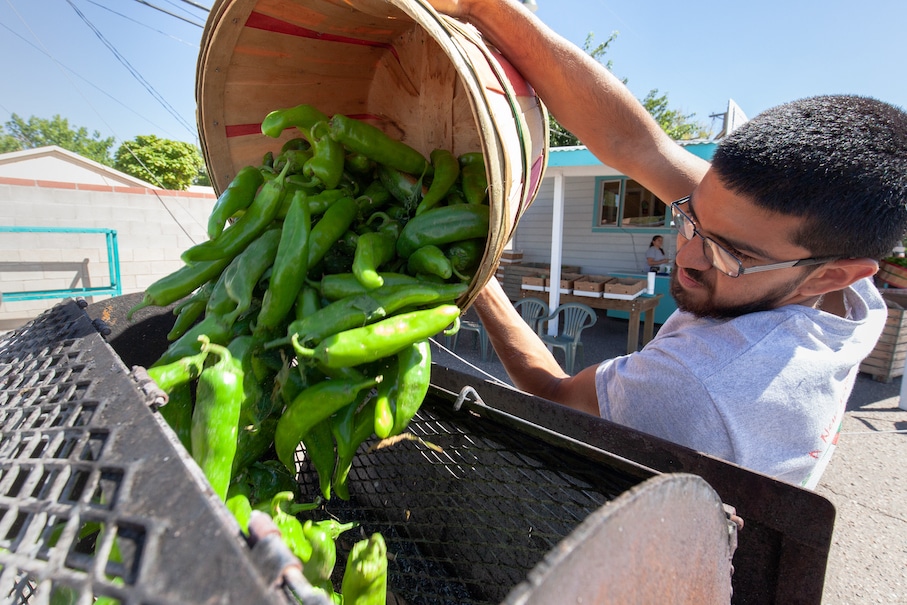
Green chiles go into the roaster at Sichler Farms in New Mexico. Photo courtesy of New Mexico TRUE
New Mexico is a land defined by its culture of green and red chiles. Chiles flavor the state’s history, cuisine, art and economy. In New Mexico, it’s all about the chile. New Mexico’s large Roman Catholic population may be shaped by its Native American, Hispanic and frontier heritage. But when it comes to food almost everyone wants theirs cooked with chiles. Both red and green.
Holy Dirt and Red Chile Powder in the North
In the shadow of the Sangre de Cristo Mountains in northern New Mexico lies an early 19th century adobe church in the rural town of Chimayó. Just 25 miles north of Santa Fe, the church houses a shrine that contains a pit with soil reputed to cure cancer.
The remote area attracts congregants and the faithful who come to worship and scoop a handful of holy earth. Nearly 300,000 pilgrims travel annually to the Santuario de Chimayó – one of the most visited holy sites in America.
Some might argue that the big attraction in Chimayó isn’t the spiritual soil, but the small store around the corner named El Potrero Trading Post. Also known as the Vigil Store, this family-owned business sells religious articles, such as retablos (saints painted on wood), bultos (carved saints) and, in case you forgot to bring your own, containers to transport home the holy dirt.
But the store also sells pleasures for the palate, notably some of the most expensive ground red chile powder in the world. Eight ounces of Chimayó Red Chile powder sells for about $22. Be prepared to stand in line and don’t bother asking for more. The chiles are rationed because of demand.
East West News Service · Living in the Land of New Mexico Chiles w/Karin Leperi Pezo – East West News Service Podcast
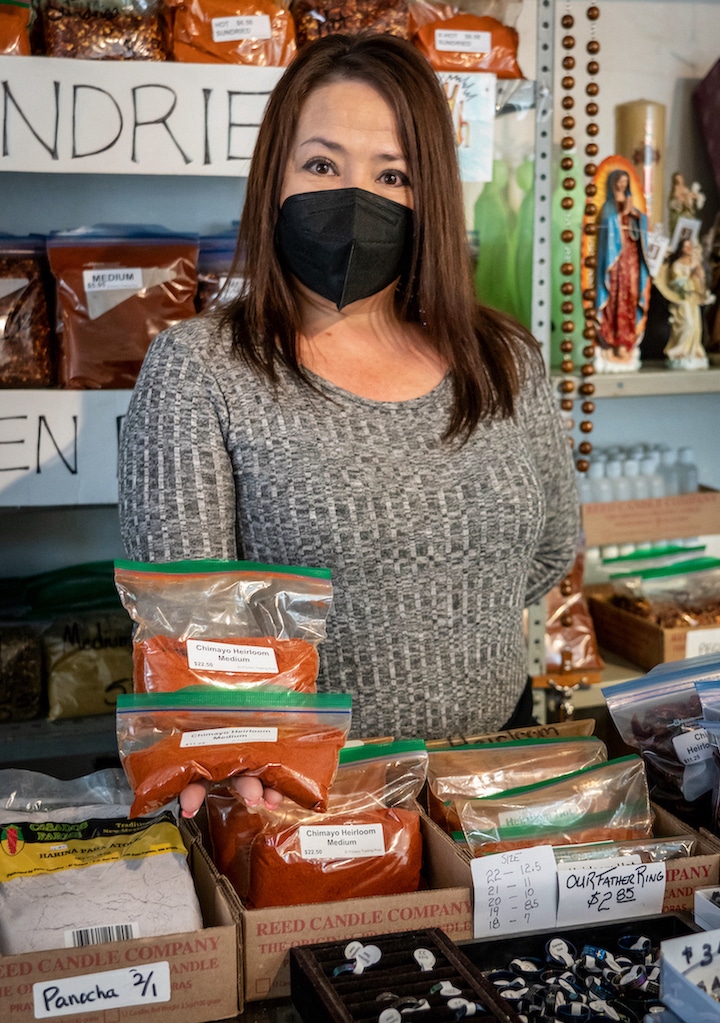
Holy dirt said to cure cancer is free for the faithful; red Chimayó Chile powder costs nearly $3 per ounce. Photo by Karin Pezo
Chimayó chiles only come from Chimayó
Chimayó Chile is grown from original heirloom seeds passed down for over four hundred years. The mature fruit provides distinctive earthy flavors while commanding a premium price due to its delicacy and scarcity. The specialized genetic makeup of this small chile goes back thousands of years to South America.
According to Florence Jaramillo, owner of Rancho de Chimayó Restaurante and winner of a 2016 James Beard Foundation America’s Classics Award, Chimayó chiles are more difficult to grow, smaller than other chiles, and require lots of water. They also favor warm days and cool nights. And because of their smaller size, it takes many more chiles to produce the famous Chimayó red chile powder.
Some say it’s the soil that gives this chile its sweet, hot, and earthy flavor. It’s the same soil as the sacred dirt in the church. For Jaramillo, “You can’t get enough of Chimayó red chile.” It is the one critical ingredient in her award-winning recipe for carne adovada. “But availability is limited and that’s why it is very expensive,” she adds.
New Mexico Chile Pepper Institute
Jaramillo says the New Mexico Chile Pepper Institute has verified that the soil is what makes the difference for the Chimayó red chile. The Institute researches more than just the red chile. It also focuses on New Mexico’s red and green chile culture.
As the only international organization devoted to the research, resource, and education of chile peppers, the institute also studies and promotes several hundred varieties of chile peppers from around the world. The Institute is located in Las Cruces on the New Mexico State University campus.

In New Mexico almost everything (save for the sopapillas in the middle of this restaurant table) is cooked with red or green chiles. Can’t decide? Then order your enchiladas “Christmas” style. Photo courtesy of New Mexico TRUE
When it comes to chile, green is just as important as red. From red chile in the northern part of the state in Chimayó to green chile in the southern part of the state in Hatch, New Mexicans love their chiles.
While Jaramillo spices her Chimayó Restaurante dishes with red chile, she acknowledges her love of the flavors of green chiles. For Gene Hellums, a software engineer, food enthusiast, and New Mexico resident relocated from Mississippi via Alaska, there is nothing better than freshly roasted green chiles. “New Mexico chiles have a unique taste not found anywhere else,” Hellums said. “To me, New Mexico chile is Hatch chile. They are synonymous.”
Hatch Green Chiles in the South
The elevation is lower and valley temperatures are hotter in Hatch and the Rio Grande Valley where New Mexican green chiles are grown. In fact, chile connoisseurs from around the world come here for the mild, nutty flavor. Green chiles are so pervasive that they are considered by many to be a staple.
But why are Hatch chiles the primus inter pares of green chile? According to Joseph Wrede, a Santa Fe chef and owner of Joseph’s Table, people should seek out Hatch green chiles because they are like what champagne is to sparkling wine. In other words, Hatch chiles are considered the top shelf of green chile.
Chiles are central to the culture, cuisine and agriculture of New Mexico
Since chiles are a ubiquitous staple in New Mexico, it only makes sense to make their status official. Indeed, the chile pepper is the official state vegetable of New Mexico. It’s unfortunate that lawmakers of yesteryear never were informed that the chile actually is a fruit rather than a vegetable.
New Mexicans spell the word differently from the rest of the country. They spell it “chile” – not to be confused with the South American country. “Chili,” also known as chili con carne, refers to the cowboy concoction slathered on hot dogs that Texans call “A bowl of red.”
New Mexicans recognize that red and green chiles have distinct flavor profiles Each has its ardent devotees but both can combine harmoniously. After all, the state’s official question when ordering dinner is “red or green?” When you want both in concert you simply ask for “Christmas.”
Residents who want to display their love for chiles can purchase an official New Mexico Chile License Plate featuring red and green chiles with the wording, “Chile Capital of the World.”
Grown in New Mexico
Not only have New Mexicans grown the capsicum annuum, the botanical name for cayenne, for hundreds of years, they have cultivated the spicy plant and its flavor profiles in rocky desert terrain. Much like wine grapes that improve their flavor in stressful conditions, chiles grown in New Mexico terroir yield a distinctive flavor you just can’t find anywhere else in the world.
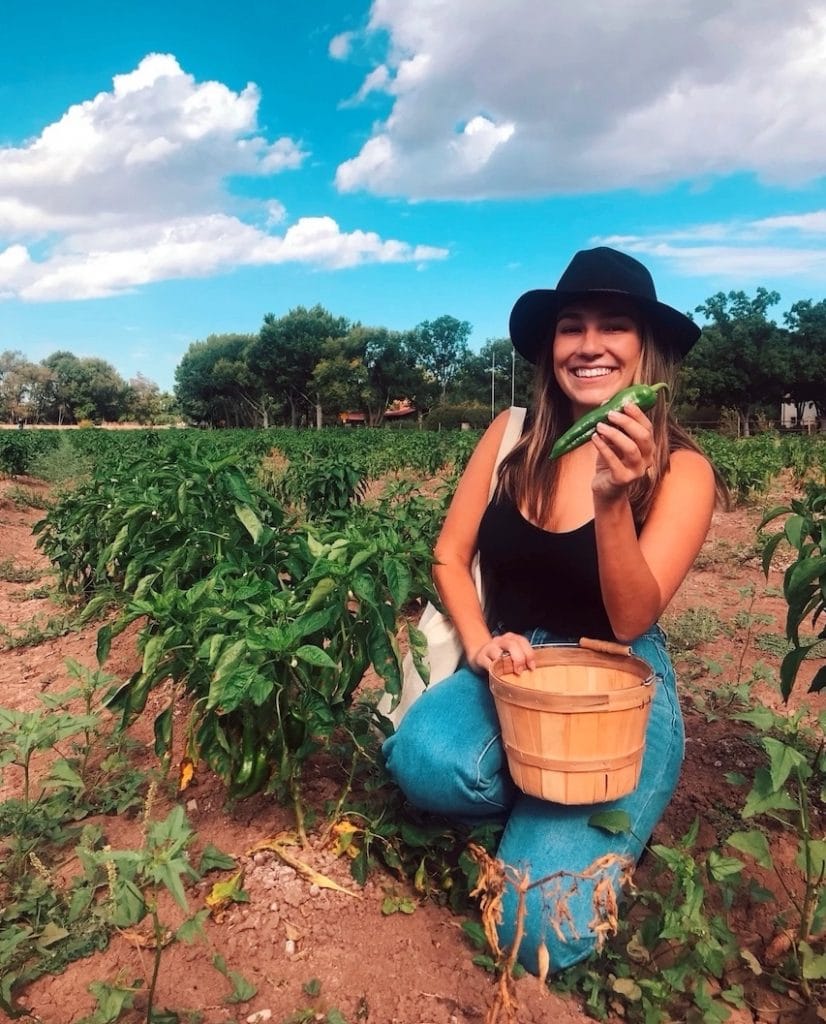
Big Jim Farms outside Albuquerque invites New Mexicans like Annalisa Pardo to pick their own chiles. Photo courtesy of Big Jim Farms
Historically, many types of chile plants were grown by Pueblo Indians. Each community developed its own strain with its own signature taste and flavor based on the soil where it was grown. Whereas the Acoma Pueblo chile is considered mild with a lightly flavorful pungency, the people of Isleta Pueblo developed a flavor profile that is fruity and sweet. Zia Pueblo is known for chiles that achieve a bitter-sweet flavor on maturity.
Nowadays, farmers like Jimmy Wagner of Big Jim Farms in Los Ranchos de Albuquerque, whose family has been farming green and red chile in the Rio Grande Valley for over 100 years, try to share the harvesting experience by opening their farms to the public. “We let the public come and pick their own chile as a learning experience,” says Wagner.
Chile as Culture and Tradition
Wagner says that one of the first things visitors to New Mexico learn is how to appreciate green and red chile. “New Mexican Chiles are special because they are ingrained into our culture,” says Wagner. “When you eat them or prepare a dish, the experience is tied to memories and traditions. It brings back the times shared with loved ones during family celebrations.”
He adds that these traditions tie us to our ancestors and are important in sharing with future generations. “Food is very personal in New Mexico. Our cultural heritage is centered around green and red chile.
Ubiquitous Chile Cuisine
New Mexico chile is pervasive in New Mexican cuisine. Chiles grow from green in the immature stage where the flavor is milder to red when it is fully ripened and the flavor is hotter.

Blue Corn Enchiladas with Green Chiles at the Range Cafe in Bernallilo. Will the customer end his meal with green chile apple pie? Photo by Karin Pezo
Green chile can be eaten whole or diced, roasted and peeled, or dried and ground into a powder. Expect green chile to be served with almost any New Mexican dish including enchiladas, burritos, hamburgers, fries, rice, or even pie. For example, The Range is a local New Mexican restaurant chain that is famous for their green chile apple pie.
Red chile is most often dried and ground to a powder. It can be oven-baked where the color is more deep red to sunbaked where the color is more reddish-orange. Dried and powdered red chiles often are used to make red chile sauce that’s blended with other herbs and spices. Then it can be used for soups, stews, chili, enchiladas, and sauces, giving a spicy and piquant flavor. The Chimayó Red Chile is considered to be the “Queen of Red.”
Chile as Art
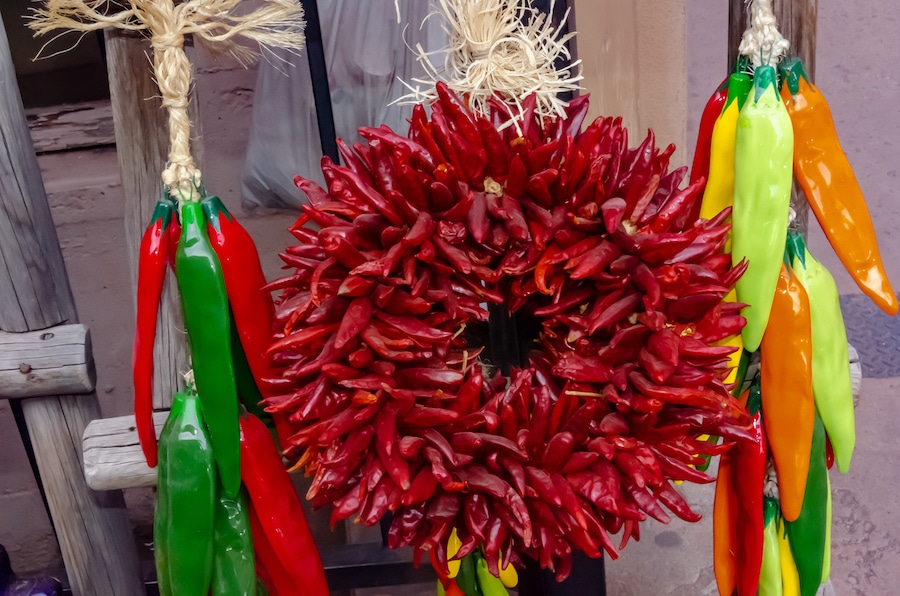
During the holiday season in New Mexico, garlands of multi-colored chile peppers called ristras often complement Christmas wreaths fashioned from dried chiles. Photo by Karin Pezo
New Mexican art and artwork is replete with chiles along with wreaths of dried chile pods called ristras that decorate adobe homes, walls, and gateways. It is an iconic decorative design associated with the Southwest and specifically, as a symbol of New Mexican culture.
And an old New Mexico poem pays homage to the power of the chile: “Roses are red. Chile is green. Our love will never vanish, just like tortillas and beans.”
Chile is important to the state’s economy
A seasonal fruit, chile is generally planted between March and April, with green chiles harvested between July and October while red chile is picked between October and December. Since the plants are delicate and pods are easily damaged, most chile is usually hand-picked by local farmers and seasonal migrants.
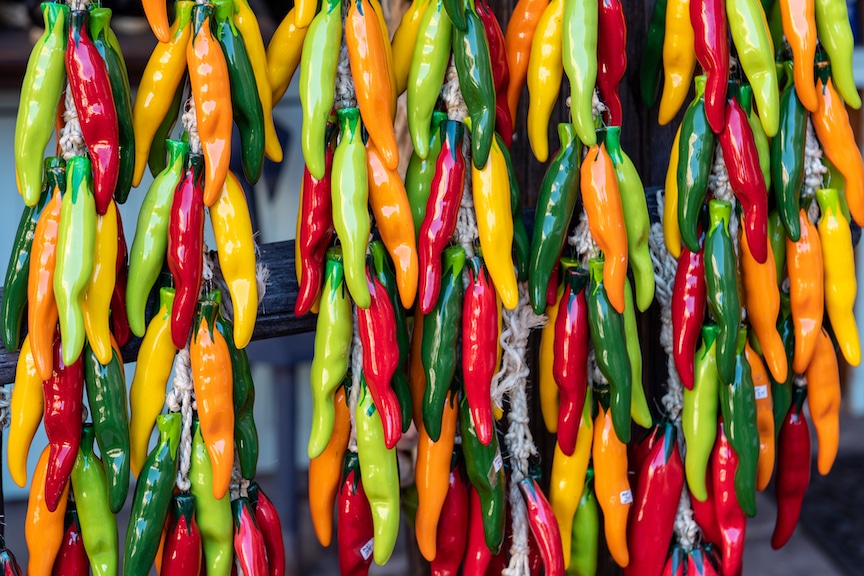
Chile color reflects the stage of growth. Green chile is the color in the immature stage, while red chile indicates the fruit is fully mature. Photo by Karin Pezo
That chile is a major crop is beyond dispute. New Mexico led the U.S. in chile production in 2019 with 63,075 tons harvested, about 77% of U.S. chile pepper production. Overall, 2019 chile crops accounted for approximately $50M in sales within New Mexico. So be sure to arrive hungry when you come to New Mexico.![]()
Karin Leperi Pezo travels the world searching for history, culture and natural wonder. A former Navy flight engineer and Defense Attaché officer in Portugal, she now lives in New Mexico.

